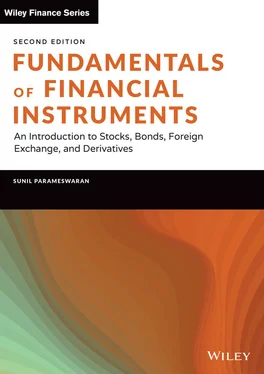1 ...8 9 10 12 13 14 ...36 The BOP is typically broken up into three major categories of accounts, each of which is further subdivided into various components. The major categories are:
The Current Account: This accounting head includes imports and exports of goods and services, factor incomes and payments, and unrequited transfers in both directions.
The Capital Account: Under this head we have the transactions that lead to changes in the foreign assets and liabilities of a country.
The Reserve Account: The reserve account is similar to the capital account, in the sense that it also deals with financial assets and liabilities. This account, however, deals only with reserve assets, which are assets used to settle the deficits and surpluses that arise on account of the other two categories taken together.
A reserve asset is one that is acceptable as a means of payment in international transactions, and which is held by and exchanged between the monetary authorities of various countries. It consists of monetary gold, assets denominated in foreign currencies, Special Drawing Rights (SDRs), and reserve positions at the International Monetary Fund (IMF). If there is a deficit in the current and capital accounts taken together, then there will be a depletion of reserves. However, if the two accounts show a surplus when taken together, there will be an increase in the level of reserves.
The balance of payments is an accounting system that is based on the double-entry system of bookkeeping. Consequently, every transaction is recorded on both sides, that is as a credit and as a debit. All transactions that have led to or will lead to a flow of payments into the country from the rest of the world will be shown as credits. The payments themselves should be shown as the corresponding debit entries. Similarly, all transactions which have led to or will lead to a flow of payments from the country to the rest of the world should be recorded as debits, and the corresponding payments should be recorded as credits.
The accounting principle can also be stated as follows. Any transaction which leads to an increase in the demand for foreign exchange should be shown as a debit, whereas any transaction which leads to an increase in the supply of foreign exchange should be shown as a credit. Thus, capital outflows will be debited, whereas capital inflows will be credited.
Why would the residents of a country demand foreign exchange? First, they may wish to pay for imports of goods or services. Second, they may want to make a dividend or interest payment to a party abroad. Third, they may want to repay a loan taken from an entity abroad. Unlike a company, a country does not have shareholders. Thus, all liabilities of the latter represent debt. It should also be clarified that a company's debt is what it owes to its banks or bondholders. In the case of a country, however, if a foreign entity were to take an equity stake in a domestic company, it would be treated as a part of the country's external debt.
Now let us analyze the receipts of foreign exchange by residents of a country. First, they may have exported goods or services. Second, they may have received dividend or interest payments from parties abroad. Third, they may have taken a loan from an entity abroad or may have liquidated a foreign financial asset.
A payment received from abroad will increase the country's foreign assets. Thus, an increase in foreign assets or a decrease in foreign liabilities will be shown as a debit. On the other hand, when a payment is made to an external party it will either reduce the country's holding of foreign assets or show up as an increase in its liabilities. This will obviously be shown as a credit.
The equivalence with corporate accounts:An export of goods and services by a country is equivalent to a sale by a company. It will be recorded as a credit, and the corresponding payment received or to be received will be recorded by debiting the cash account or the receivables account, if the sale is made on credit. Similarly, an import of goods and services is like a purchase by a company. It will be recorded as a debit and the payment, if made immediately, will be shown by crediting cash, or by crediting the creditor's account if the counterparty has supplied on credit. Dividends and interest payments made to foreign parties are equivalent to expenses for a company and will be debited. Inward dividends and interest are equivalent to income and will be credited. As we said earlier, a country has only creditors and no shareholders. Consequently, foreign liabilities will go up with credits and down with debits. Unlike a company's reserves, which belong to the shareholders and are consequently a liability for it, a country's reserves are an asset for it. Thus, a country's reserves will increase with debits and decline with credits.
Unrequited or unilateral transfers may be perceived as follows. Inward transfers are like purchases by a company, where the supplier has extended a 100% discount. On the other hand, outward transfers are like sale transactions, where the company concerned has offered a 100% discount.
Clearly, the balance of payments must always balance. Thus, a current account deficit must be matched by a surplus in the capital account or by a depletion of reserves, or both. A surplus in the capital account would indicate that the country's foreign liabilities have gone up, or, in other words, that it has borrowed from abroad. In the case of a company, if the net income for a period is negative, then either its liabilities must correspondingly increase, or its assets must decline. However, If the net income were to be positive, it would manifest itself as a reduction in the entity's liabilities or as an increase in its assets.
While analyzing the BOP, it is customary to study several subcategories of accounts. We will now look at two of the most important sub-classifications.
The balance of trade is equal to the total of merchandise exports and imports. It consists of all raw materials and manufactured goods bought, sold, or given away. If it shows a surplus, it indicates that exports of goods from the country exceed imports into it, whereas if it shows a deficit, it would obviously indicate that imports exceed exports. The balance of trade is a politically sensitive statistic. If a country's balance of trade shows a deficit, industries that are being hurt by competition from abroad will typically raise a hue and cry about the need for a level playing field to take on the foreign competition.
THE CURRENT ACCOUNT BALANCE
The current account balance refers to the total of the following accounts:
Exports of goods, services, and income
Imports of goods, services, and income
Net unilateral transfers
Services include tourism, transportation, engineering, and business services. Fees from patents and copyrights are also recognized under this category. Income includes revenue from financial assets, such as dividends from shares and interest from debt securities. Unilateral transfers are one-way transfers of assets, such as worker remittances from foreign countries and direct foreign aid.
The net foreign assets of a country may be defined as its foreign assets minus its foreign liabilities. If the net foreign assets are positive, then the nation may be deemed to be a creditor nation; otherwise, it is a debtor nation. The change in the current account is equal to the change in net foreign assets.

If a country has a current account surplus, either its foreign assets will increase or its foreign liabilities will decline. On the contrary, if a country has a current account deficit, either its foreign assets will decline or its foreign liabilities will increase.
Читать дальше













